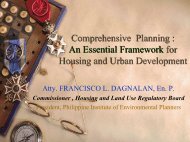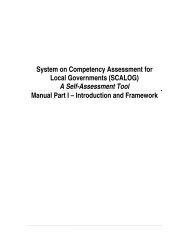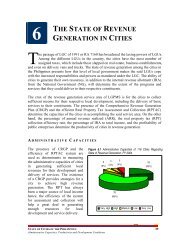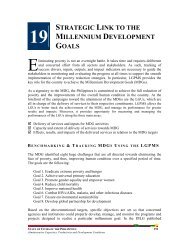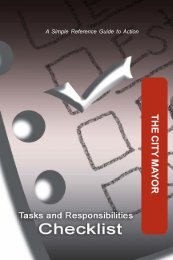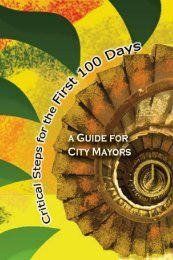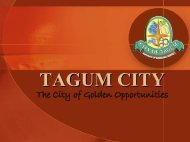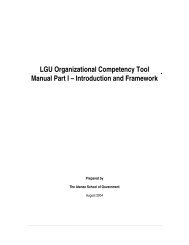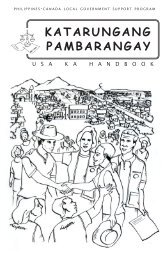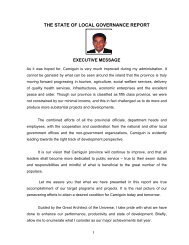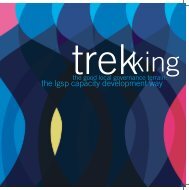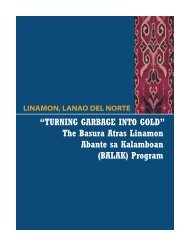the palma alliance - LGRC DILG 10
the palma alliance - LGRC DILG 10
the palma alliance - LGRC DILG 10
You also want an ePaper? Increase the reach of your titles
YUMPU automatically turns print PDFs into web optimized ePapers that Google loves.
THE PALMA ALLIANCE:<br />
PIGCAWAYAN, ALAMADA,<br />
LIBUNGAN, MIDSAYAP, &<br />
ALEOSAN COTABATO PROVINCE<br />
“ALL FOR ONE AND ONE FOR ALL”<br />
Building LGU Alliances for<br />
Infrastructure Development
“ALL FOR ONE AND ONE FOR ALL”<br />
Building LGU Alliances for Infrastructure Development<br />
Copyright © 2004 Philippines-Canada Local Government Support Program<br />
(LGSP)<br />
The Philippines-Canada Local Government Support Program encourages <strong>the</strong><br />
use, translation, adaptation and copying of this material for non-commercial<br />
use, with appropriate credit given to LGSP.<br />
Although reasonable care has been taken in <strong>the</strong> preparation of this book,<br />
nei<strong>the</strong>r <strong>the</strong> publisher and/or contributor and/or editor can accept any liability<br />
for any consequence arising from <strong>the</strong> use <strong>the</strong>reof or from any information<br />
contained herein.<br />
Printed and bound in Manila, Philippines<br />
Published by:<br />
Philippines-Canada Local Government Support Program<br />
Unit 1507 Jollibee Plaza<br />
Emerald Ave., Pasig City<br />
1600 Philippines<br />
Tel. Nos. (632) 637-3511 to 13<br />
www.lgsp.org.ph<br />
This project was undertaken with <strong>the</strong> financial support of <strong>the</strong> Government of<br />
Canada provided through <strong>the</strong> Canadian International Development Agency<br />
(CIDA).
CONTENTS<br />
Summary<br />
About Kabalikat Palma Infrastructure Project (KPIP)<br />
Project History<br />
Implementing The Palma Kabalikat Infrastructure: Objectives,<br />
Structures, And Mechanics<br />
Project Results<br />
Replicating Kabalikat Palma Infrastructure Project<br />
Key Implementation Steps<br />
Reference Matrix On Replicating Kabalikat Palma Infrastructure<br />
Project<br />
Lessons For Replication: Keeping The Engines Running<br />
Annexes<br />
1<br />
3<br />
3<br />
4<br />
7<br />
8<br />
8<br />
12<br />
14<br />
17
Summary<br />
In August 2001, mayors of five neighboring towns in Cotabato Province who were<br />
attending <strong>the</strong> Chief Executives Development Management Program (LDMP) at <strong>the</strong><br />
Asian Institute of Management came up with a brilliant idea. They decided to pool <strong>the</strong><br />
resources of <strong>the</strong>ir municipalities toge<strong>the</strong>r to help each o<strong>the</strong>r rehabilitate and construct<br />
barangay and farm-to-market roads.<br />
Thus was <strong>the</strong> Kabalikat PALMA Infrastructure<br />
Project (KPIP) born. “Kabalikat”, a Tagalog<br />
term meaning shoulder-to-shoulder or each<br />
one lending a shoulder to ano<strong>the</strong>r became <strong>the</strong><br />
name and guiding principle of <strong>the</strong> project. The<br />
KPIP also became <strong>the</strong> first project of what came<br />
to be known as <strong>the</strong> PALMA local government<br />
<strong>alliance</strong>.<br />
“ALL FOR ONE AND<br />
ONE FOR ALL”<br />
Building LGU Alliances<br />
for Infrastructure<br />
Development<br />
Under Kabalikat, <strong>the</strong> five municipalities of<br />
Pigcawayan, Alamada, Libungan, Midsayap<br />
and Aleosan comprising <strong>the</strong> PALMA Alliance<br />
pooled <strong>the</strong>ir road construction equipment and<br />
systematically rotated equipment use among<br />
<strong>the</strong>mselves free of charge. Each municipality<br />
made a contribution to <strong>the</strong> equipment pool.<br />
Pigcawayan brought in its road grader and<br />
dump truck. Alamada shared <strong>the</strong>ir road grader<br />
bulldozer, backhoe loader and dump truck.<br />
Libungan put in a road grader, dump truck<br />
and backhoe loader. Midsayap contributed a<br />
The Kabalikat PALMA<br />
Infrastructure Project of<br />
<strong>the</strong> PALMA Alliance:<br />
Pigcawayan, Alamada,<br />
Libungan, Midsayap,<br />
& Aleosan Cotabato<br />
Province<br />
bulldozer, backhoe loader, pay loader, compactor and dump truck. Aleosan its road<br />
grader, bulldozer, pay loader and dump truck.<br />
To support <strong>the</strong> effort, <strong>the</strong> provincial government of Cotabato provided <strong>the</strong> trailer for<br />
transporting <strong>the</strong> heavy equipment and made available a road construction team for <strong>the</strong><br />
project.<br />
The spirit of LGUs helping one ano<strong>the</strong>r deliver infrastructure services through equitable<br />
sharing of resources proved to <strong>the</strong> great benefit of <strong>the</strong> LGUs. With better roads made<br />
possible through <strong>the</strong> project, residents, especially in remote barangays, can now be<br />
reached by government extension workers. These barangays have also been exposed<br />
1
“All for One and One for All” Building LGU Alliances for Infrastructure Development<br />
to various farming technologies, which have increased <strong>the</strong>ir agricultural productivity. The<br />
project has also reduced <strong>the</strong> cost of road construction for <strong>the</strong> LGUs, and decreased travel<br />
time and transport cost for hundreds of residents.<br />
2
The Kabalikat PALMA Infrastructure Project: Pigcawayan, Alamada, Libungan, Midsayap, & Aleosan Cotabato Province<br />
ABOUT THE PALMA KABALIKAT INFRASTRUCTURE PROJECT<br />
Addressing a Need, Helping Neighbors: Project History<br />
Like many rural municipalities in <strong>the</strong> Philippines, <strong>the</strong> five municipalities of Cotabato Province<br />
of <strong>the</strong> PALMA <strong>alliance</strong> shared a common problem. Because of poor roads, several of <strong>the</strong>ir<br />
upland and far flung barangays were deprived of basic services and faced limited prospects<br />
for growth. Residents from <strong>the</strong>se barangays found it difficult to commute and transport <strong>the</strong>ir<br />
farm produce to <strong>the</strong> market.<br />
But because of limited resources, individual local government units (LGUs) could ill afford<br />
massive rehabilitation or construction of barangay or farm to market roads.<br />
To address <strong>the</strong> problem, Mayor Ronaldo B. Pader of Libungan, who is concurrently <strong>the</strong> Chair<br />
of <strong>the</strong> PALMA Alliance Board, broached <strong>the</strong> idea of pooling <strong>the</strong> equipment of five towns to<br />
fast track <strong>the</strong>ir respective infrastructure development with 4 mayors of neighboring towns<br />
who were also attending <strong>the</strong> Chief Executives Development Management Program (LDMP)<br />
conference. All four mayors readily accepted Pader’s idea. Initial discussions on how to<br />
implement <strong>the</strong> project were made.<br />
The five mayors subsequently met to formulate <strong>the</strong> mechanics for project implementation<br />
and to formalize <strong>the</strong> arrangement in a Memorandum of Agreement. The MOA was signed<br />
on October 31, 2001 signifying <strong>the</strong> intentions of 5 LGUs to implement <strong>the</strong> PALMA Kabalikat<br />
project as an <strong>alliance</strong>.<br />
In February 2002, <strong>the</strong> first rotation of infra- equipment was made. It covered 20 barangays in<br />
<strong>the</strong> municipality of Aleosan where approximately 12 kms of barangay road were completed.<br />
Each municipality got its turn to use <strong>the</strong> equipment until <strong>the</strong> early part of January 2003. A<br />
total of 70 kilometers of barangay farm to market roads in 27 barangays in <strong>the</strong> 5 municipalities<br />
were rehabilitated under <strong>the</strong> first rotation. The project is now on its second round.<br />
Before and After construction shots of <strong>the</strong> Aleosan Tomado-Malapang Road<br />
3
“All for One and One for All” Building LGU Alliances for Infrastructure Development<br />
Implementing <strong>the</strong> PALMA Kabalikat Infrastructure: Objectives, Structures and Mechanics<br />
Objectives<br />
PALMA KABALIKAT aims to fast track <strong>the</strong> rehabilitation of barangay and farm to market<br />
roads in order to make government services accessible to people and assist <strong>the</strong>se barangays<br />
achieve development, progress and prosperity.<br />
Organizational Structure<br />
At <strong>the</strong> <strong>alliance</strong> level, two committees were formed:<br />
1. Infrastructure Project Steering Committee (IPSC); and<br />
2. Infrastructure Project Technical Working Group (IPTWG)<br />
The Infrastructure Project Steering Committee has 12 members, including:<br />
• Mayors of 5 Municipalities<br />
• MPDC of 5 Municipalities<br />
• SB member of <strong>the</strong> Infra Committee of 5 municipalities<br />
• One (1) Municipal Engineer chosen from amongst <strong>the</strong> municipalities<br />
• Provincial Planning and Development Officer<br />
• One (1) representative from <strong>the</strong> Office of <strong>the</strong> Congressman<br />
The IPSC is tasked to:<br />
• Oversee <strong>the</strong> establishment and implementation of <strong>the</strong> Infrastructure Project<br />
• Discuss and agree on matters related to fund sourcing, appropriation of funds and equity<br />
sharing<br />
• Ensure all LGUs equitably benefit from <strong>the</strong> Infrastructure Project<br />
• Approve <strong>the</strong> scheduling of projects<br />
• Settle disputes among <strong>the</strong> participating LGUs<br />
The Inter LGU Infrastructure Technical Working Group (IPTWG), on <strong>the</strong> o<strong>the</strong>r hand, is<br />
composed of:<br />
• Municipal Engineers from all municipalities<br />
• MPDCs from all municipalities<br />
• CSO representative (President of <strong>the</strong> Farmers’ Association) involved in <strong>the</strong> Project<br />
Monitoring and Evaluation Committee from each municipality<br />
4
The Kabalikat PALMA Infrastructure Project: Pigcawayan, Alamada, Libungan, Midsayap, & Aleosan Cotabato Province<br />
The IPTWG has <strong>the</strong> following mandate:<br />
• Prepare Program of Work for each municipality<br />
• Establish and recommend project schedules<br />
• Prepare listings of heavy equipment required for <strong>the</strong> respective projects<br />
• Supervise <strong>the</strong> implementation of <strong>the</strong> respective projects<br />
• Coordinate (jointly with <strong>the</strong> respective municipalities) <strong>the</strong> logistical requirements of <strong>the</strong><br />
projects<br />
• Monitor, evaluate and provide feedback to <strong>the</strong> IPSC<br />
Project Mechanics<br />
To operationalize this project, <strong>the</strong> five mayors agreed on <strong>the</strong> following mechanics:<br />
1. The project shall be rotated within <strong>the</strong> five (5) member municipalities, starting from <strong>the</strong><br />
municipality/barangay where <strong>the</strong> need is most crucial, and until such time that all <strong>the</strong><br />
farm-to-market roads in all <strong>the</strong> barangays within <strong>the</strong> Alliance shall have become allwea<strong>the</strong>r<br />
roads.<br />
2. Each member municipality shall provide only <strong>the</strong> road construction equipment needed<br />
in <strong>the</strong> particular project.<br />
3. All <strong>the</strong> necessary equipment for <strong>the</strong> project shall be simultaneously mobilized to maximize<br />
time and ensure project completion within <strong>the</strong> target period. Equipment are garaged<br />
within <strong>the</strong> project area throughout project duration, but may be withdrawn at any time by<br />
<strong>the</strong> LGU owner during emergencies.<br />
A fleet of equipment includes a bulldozer, a grader, a pay loader/back hoe loader,<br />
3-4 dump trucks, and a road compactor. Usually 2 fleets are deployed in <strong>the</strong><br />
project to be able to finish an aggregate total of <strong>10</strong>-15 kilometers of road during <strong>the</strong><br />
project duration of <strong>10</strong> working days.<br />
4. Each project must have a minimum duration of only ten (<strong>10</strong>) working days (under normal<br />
conditions).<br />
It is recommended that <strong>the</strong> bulldozer be brought to <strong>the</strong> project site 2-3 days<br />
before <strong>the</strong> actual project implementation to prepare an adequate amount of quarry<br />
materials needed for <strong>the</strong> project. Implementation of <strong>the</strong> project takes place in an<br />
average of ten (<strong>10</strong>) days under normal conditions. There is an average of one (1) km.<br />
road accomplishment per day. In cases where <strong>the</strong> conditions are more difficult, <strong>the</strong><br />
host LGU may request for an extension.<br />
5
“All for One and One for All” Building LGU Alliances for Infrastructure Development<br />
Before and After construction shots of <strong>the</strong> Aleosan Tomado-Malapang Road<br />
5. The host municipality shall provide for <strong>the</strong> prime mover/trailer for <strong>the</strong> transport of <strong>the</strong><br />
heavy equipment (bulldozer, vibrator/compactor, pay loader).<br />
6. The drivers and operators shall be provided with P200.00/day honorarium each, aside<br />
from provision of food and sleeping quarters.<br />
7. The host municipality will provide for <strong>the</strong> fuel, oil, and lubricants for use of <strong>the</strong> equipment<br />
during <strong>the</strong> project implementation.<br />
8. The host municipality shall also provide security personnel or peacekeeping forces to<br />
secure <strong>the</strong> project area and its premises.<br />
9. Minor repairs of <strong>the</strong> equipment costing P1,000.00 or less shall be shouldered by <strong>the</strong> host<br />
LGU, but repair costs over P1,000.00 shall be borne by <strong>the</strong> LGU owner.<br />
The five (5) mayors also agreed that equipment would come rent free to highlight <strong>the</strong> bayanihan<br />
spirit that <strong>the</strong>y wanted to cultivate. These mechanics were outlined in <strong>the</strong> memorandum of<br />
agreement signed by <strong>the</strong> 5 mayors<br />
Making Available Appropriate Resources<br />
To show <strong>the</strong> LGU’s commitment to <strong>the</strong> <strong>alliance</strong>, PALMA committed to put up 2million pesos<br />
for <strong>the</strong> project management office that would take charge of <strong>the</strong> day-to-day operations of <strong>the</strong><br />
KABALIKAt infrastructure project and o<strong>the</strong>r <strong>alliance</strong> projects. Each LGU agreed to contribute<br />
200,000 pesos per year to <strong>the</strong> <strong>alliance</strong>.<br />
6
The Kabalikat PALMA Infrastructure Project: Pigcawayan, Alamada, Libungan, Midsayap, & Aleosan Cotabato Province<br />
Project Results: Multiplying Resources Lead To Multiple Benefits<br />
Sharing resources has resulted in benefits that are shared by all 5 municipalities<br />
1. Opening up of upland barangays to development<br />
The project provided upland barangays with access to modern farming upland technology<br />
and made basic services from government and <strong>the</strong> private sector more accessible.<br />
2. Increased agricultural productivity<br />
After <strong>the</strong> completion of <strong>the</strong> roads, <strong>the</strong> production of traditional crops such as corn and<br />
vegetables increased by as much as 20%.<br />
3. Reduced road construction cost<br />
Ordinarily, <strong>the</strong> cost for <strong>the</strong> rehabilitation of a barangay farm to market road per kilometer<br />
is P800,000.00 to P1M based on <strong>the</strong> MRDP standard. With <strong>the</strong> Kabalikat PALMA<br />
Infrastructure Project, a <strong>10</strong>-15 km all wea<strong>the</strong>r FMR cost each LGU/barangay only P350,000<br />
to P500,000 or an estimate of P35,000-50,000 per km. of road. This in turn, freed up<br />
more LGU funds for o<strong>the</strong>r development projects.<br />
4. Reduced travel distance and time<br />
Before <strong>the</strong> road rehabilitation, <strong>the</strong> distance and travel time to <strong>the</strong> town centers took a<br />
longer time. After <strong>the</strong> project was implemented, travel time was reduced to as much as<br />
50%, making travel faster, more convenient and less costly to residents.<br />
5. Reduced transport and passenger fares<br />
Passenger fares for both jeepneys (6 wheelers) and “habal-habal” (single motorcycle for<br />
hire) were reduced by 20% and transportation costs of products/goods also went down<br />
by as much as 60%, contributing to greater savings for commuters and more profit for<br />
farmers.<br />
6. Accessibility of government service and assistance<br />
Far flung barangays, especially those classified as “critical” areas due to peace and<br />
order problems have become more accessible to government services and assistance.<br />
The government’s presence through <strong>the</strong> services being provided is concretely felt by <strong>the</strong><br />
residents especially in <strong>the</strong> so-called critical areas. This has, in a way, contributed in<br />
addressing some of <strong>the</strong> peace and order problems affecting <strong>the</strong> area.<br />
7. Instilling discipline and mutual respect among barangays<br />
The project also instilled discipline among barangay officials who respected <strong>the</strong> criteria for<br />
prioritization of barangays to be served. The pulling out of equipment from <strong>the</strong> barangay<br />
sites where <strong>the</strong> project is on-going is minimized even if <strong>the</strong>re is a perceived urgent request<br />
from o<strong>the</strong>r barangays. The difficulty on <strong>the</strong> part of <strong>the</strong> LCE of explaining to <strong>the</strong> Punong<br />
Barangay when such requests are not granted is lessened.<br />
7
“All for One and One for All” Building LGU Alliances for Infrastructure Development<br />
8. Spreading <strong>the</strong> spirit of Bayanihan<br />
In <strong>the</strong> meantime, <strong>the</strong> “bayanihan” spirit that spurred <strong>the</strong> project has spread to o<strong>the</strong>r activities,<br />
including <strong>the</strong> hosting of barangays of <strong>the</strong> equipment and workers. Preparing food and<br />
lodging for <strong>the</strong> road workers has also become a bayanihan activity at <strong>the</strong> barangay level.<br />
On <strong>the</strong> side of <strong>the</strong> field implementors (<strong>the</strong> drivers and operators of <strong>the</strong> heavy equipment),<br />
<strong>the</strong> friendship, camaraderie and bonding among <strong>the</strong>mselves motivated <strong>the</strong>m work harder<br />
and more effectively, unmindful of additional work hours <strong>the</strong>y need to put in.<br />
REPLICATING THE PALMA KABALIKAT INFRASTRUCTURE<br />
PROJECT<br />
The spirit and initiative of KABALIKAT is now being replicated by o<strong>the</strong>r LGUs, with <strong>the</strong><br />
following identified implementation steps.<br />
Key Implementation Steps<br />
A. Pre-Implementation<br />
1. Create an Alliance or Inter-LGU Organizational Structure to Manage <strong>the</strong> Infrastructure<br />
project and two committees are required:<br />
• An Infrastructure Project Steering Committee (IPSC); and<br />
• A Infrastructure Project Technical Working Group (IPTWG)<br />
Scenario 1: If <strong>the</strong> LGU wants to create an Alliance like that of PALMA.<br />
a. Conduct meeting of LCEs of participating LGUs to discuss forming of Alliance to be<br />
initiated by <strong>the</strong> Provincial Government. The discussion will focus on <strong>the</strong> need to create<br />
an <strong>alliance</strong>, how it will be established, how it will be managed, who composes <strong>the</strong><br />
board, functions and responsibilities of <strong>the</strong> board, roles and responsibilities of LGUs<br />
(contributions), setting up <strong>the</strong> PMO, drafting of MOA(creation and operationalization of<br />
<strong>alliance</strong>), formulation of strategic plan, manual of operations.<br />
b. Subsequent meeting can focus on defining mechanics for implementation, establish<br />
criteria to be used in identifying and prioritizing LGU to be initially benefited by <strong>the</strong><br />
project, drafting <strong>the</strong> MOA and agreeing on project rotation and time-frame.<br />
8
The Kabalikat PALMA Infrastructure Project: Pigcawayan, Alamada, Libungan, Midsayap, & Aleosan Cotabato Province<br />
Scenario 2: Setting-up of Inter-LGU Organization Structure to manage <strong>the</strong> Infrastructure<br />
Project in lieu of an <strong>alliance</strong> PMO<br />
Conduct of meetings among LCEs and o<strong>the</strong>r technical staff of participating LGUs to discuss<br />
<strong>the</strong> following:<br />
- Mechanics of implementation<br />
- Creation of Inter-LGU Infrastructure Project Steering Committee and TWG<br />
- Drafting of MOA<br />
2. Enact appropriate legal and legislative measures to support <strong>the</strong> project at <strong>the</strong> <strong>alliance</strong><br />
and municipal level:<br />
Municipal Level<br />
Sangguniang Bayan Resolution<br />
The respective Sangguniang Bayans issue a<br />
resolution authorizing <strong>the</strong> Local Chief Executives<br />
to enter into a Memorandum of Agreement with<br />
<strong>the</strong> o<strong>the</strong>r LGUs. The MOA includes <strong>the</strong> allocation<br />
of funds, inventory of heavy equipment and <strong>the</strong><br />
specific details of <strong>the</strong> implementation mechanics.<br />
Alliance Level<br />
Memorandum of agreement and agreement on<br />
<strong>the</strong> implementation mechanics<br />
The MOA includes <strong>the</strong> allocation of funds,<br />
inventory of heavy equipment and <strong>the</strong> specific<br />
details of <strong>the</strong> implementation mechanics.<br />
3. At <strong>the</strong> municipal level, conduct pre-implementation activities for infrastructure projects<br />
including:<br />
a. Establish <strong>the</strong> criteria for identifying priority barangays and identify/prioritize barangays<br />
to be served by project<br />
This can be done through a meeting with <strong>the</strong> mayor, MPDC , Municipal Engineer and<br />
SB committee on infrastructure to formulate and agree on <strong>the</strong> criteria for identifying<br />
priority barangays. Based on <strong>the</strong> agreed criteria, <strong>the</strong> group can compile a shortlist of<br />
beneficiary barangays . The list will <strong>the</strong>n forwarded to MDC and SB for approval.<br />
Example of <strong>the</strong> criteria used as <strong>the</strong> bases for identifying priority barangays in<br />
PALMA:<br />
1) The barangay is not qualified to avail of o<strong>the</strong>r foreign assisted projects like <strong>the</strong><br />
MRDP, STAR-CM;<br />
2) Far-flung/hard-to-reach;<br />
9
“All for One and One for All” Building LGU Alliances for Infrastructure Development<br />
3) Productive, but economic development is hindered because of <strong>the</strong> dismal condition<br />
of roads;<br />
4) Critical, in terms of peace and order situation where government service has not<br />
been felt by <strong>the</strong> constituents.<br />
b. Present <strong>the</strong> Barangay Short list to <strong>the</strong> Municipal Development Council for deliberation.<br />
The Municipal Development Council (MDC), after deliberation, recommends <strong>the</strong><br />
inclusion of <strong>the</strong> identified priority barangays in <strong>the</strong> allocation of funds in <strong>the</strong> Annual<br />
Investment Plan (AIP). (The MDC planning and budgeting usually takes place in<br />
October). The AIP is submitted to <strong>the</strong> Sangguniang Bayan for approval of budget<br />
allocation.<br />
c. Conduct a survey of <strong>the</strong> roads in <strong>the</strong> selected barangays<br />
• Road survey usually takes one week.<br />
• Barangay counterpart to <strong>the</strong> Project is discussed during this time.<br />
• The Punong Barangay (barangay chair) negotiates for <strong>the</strong> deed of donation for <strong>the</strong><br />
road right of way (ROW) .<br />
d. Prepare <strong>the</strong> Program of Work<br />
• Municipal Engineer prepares <strong>the</strong> Program of Work and submits <strong>the</strong> list of equipment<br />
needed to <strong>the</strong> Local Chief Executive.<br />
• The LCE endorses <strong>the</strong> request to <strong>the</strong> PMO for <strong>the</strong> preparation of <strong>the</strong> communication<br />
indicating <strong>the</strong> list of <strong>the</strong> needed equipment to be fielded for <strong>the</strong> project and its<br />
subsequent distribution<br />
e. Create a working Committee to support <strong>the</strong> project at <strong>the</strong> barangay level, including<br />
committee on accommodation, food preparation and Peace and Order.<br />
f. Prepare a budget for day-to-day operations<br />
The LCE can set a meeting with <strong>the</strong> Municipal Budget Officer, <strong>the</strong> Municipal<br />
Accountant, and <strong>the</strong> Municipal Treasurer, to discuss fund releases and person/s<br />
responsible for cash withdrawals from <strong>the</strong> Municipal Treasurer for <strong>the</strong> day-to-day<br />
necessary expenses of <strong>the</strong> Project.<br />
g. Obtain <strong>the</strong> heavy equipment from o<strong>the</strong>r LGUs<br />
The PMO prepares <strong>the</strong> communication addressed to <strong>the</strong> o<strong>the</strong>r four (4) LCEs thru <strong>the</strong><br />
respective Municipal Engineers specifying <strong>the</strong> specific equipment needed to be fielded<br />
for <strong>the</strong> project and to <strong>the</strong> Provincial Engineer for <strong>the</strong> use of <strong>the</strong> Prime Mover/Trailer.<br />
h. Prepare <strong>the</strong> opening ceremony (launching) in <strong>the</strong> Barangay<br />
<strong>10</strong>
The Kabalikat PALMA Infrastructure Project: Pigcawayan, Alamada, Libungan, Midsayap, & Aleosan Cotabato Province<br />
Before and After construction shots of <strong>the</strong> Aleosan Tomado-Malapang Road<br />
B. Project Implementation<br />
1. Conduct an opening ceremony at <strong>the</strong> Barangay level where each road project is<br />
undertaken<br />
2. Implement <strong>the</strong> infrastructure project<br />
3. Supervise and monitor <strong>the</strong> project<br />
The host LGU Project Engineer and a PMO representative monitors <strong>the</strong> timeliness, quality<br />
of work and compliance based on <strong>the</strong> program of work, as well as identifies minor<br />
problems and interventions needed.<br />
4. Facilitate Project Completion, Turn-Over, Socialization and Fellowship<br />
5. Prepare for Reporting and Feedbacking to <strong>the</strong> IPSC<br />
• Submit Accomplishments Report to <strong>the</strong> participating municipalities and <strong>the</strong> provincial<br />
government<br />
• Ensure equipment check and maintenance by proceeding to check <strong>the</strong> condition of <strong>the</strong><br />
equipment and undertaking appropriate maintenance.<br />
• Initiate preparations and project cycle for <strong>the</strong> next Project<br />
6. Conduct Information and Promotion Activities to Build Popular Support<br />
Examples of activities undertaken by PALMA Alliance: 1-hour PALMA Alliance Radio<br />
program aired every Friday afternoon over Radio Station DXMS and <strong>the</strong> quarterly<br />
publication of <strong>the</strong> <strong>alliance</strong> “KABALIKAT”<br />
11
“All for One and One for All” Building LGU Alliances for Infrastructure Development<br />
Table 1. Reference Matrix for Replication<br />
Key Implementation Steps/Stage Timeline Estimated budget required<br />
1. Create an Alliance or Inter-LGU<br />
organizational structure<br />
Cost of series of meetings/<br />
workshops such as; meals and<br />
snacks, accommodation for live-in<br />
workshops, traveling expenses of<br />
LGU staff for live-out workshops<br />
(especially in formulating <strong>the</strong><br />
MOA, Manual of Operations,<br />
Strategic Plan) , Honoraria of<br />
Facilitators, supplies and materials,<br />
reproduction of documents.<br />
1.1 Scenario 1: Creating an Alliance 4-6 months Cost of meetings such as; meals<br />
and snacks, supplies and materials.<br />
1.2 Scenario 2: Setting-up of Inter-LGU<br />
Organization Structure to manage<br />
<strong>the</strong> Infrastructure Project in lieu of an<br />
<strong>alliance</strong> PMO<br />
2. Enact legal and legislative measures None<br />
3. Sign Memorandum of Agreement among ½ day<br />
LGUs<br />
4. Municipal Level Pre Implementation 1 week and 2<br />
days<br />
a. Identify priority projects per<br />
2 days<br />
municipality / Make Short list<br />
b. Approval of <strong>the</strong> short listed barangays<br />
to <strong>the</strong> MDC and SB for budgetary<br />
allocation<br />
c. Conduct survey of roads in shortlisted<br />
barangays<br />
3 -4 weeks Traveling expenses of LGU officials<br />
and staff attending <strong>the</strong> meetings.<br />
Cost of snacks for <strong>the</strong> ceremonial<br />
signing of MOA<br />
1 week Cost of meetings<br />
1 week Meals and snacks of surveyors, fuel<br />
and gasoline for <strong>the</strong> vehicle used in<br />
<strong>the</strong> survey .<br />
d. Submit program of work prepared by<br />
municipal engineer to PMO<br />
Meals and snacks:<br />
P 250/surveyor x 9 surveyors x 5<br />
days = P 11,250.00<br />
Fuel and gasoline:<br />
P 500.00 for 5 days survey<br />
2 weeks Supplies and materials<br />
12
The Kabalikat PALMA Infrastructure Project: Pigcawayan, Alamada, Libungan, Midsayap, & Aleosan Cotabato Province<br />
Key Implementation Steps/Stage Timeline Estimated budget required<br />
e. Create working committees at <strong>the</strong><br />
barangay level to support <strong>the</strong> project<br />
f. Prepare a budget for <strong>the</strong> day to day<br />
operations of <strong>the</strong> project<br />
g. Get heavy equipment from<br />
participating LGUs<br />
1 day None<br />
1 day None<br />
3 days Fuel and gasoline for <strong>the</strong> prime<br />
mover: P 3,600.00<br />
Honorarium of operators/drivers<br />
of prime mover: P500/unit x 5<br />
units= P2,500<br />
h. Prepare for <strong>the</strong> opening ceremony 2 days Supplies and materials for <strong>the</strong><br />
stage decors and printing and<br />
reproduction of invitation and<br />
program<br />
PROJECT-IMPLEMENTATION PHASE<br />
5. Conduct an opening ceremony/project<br />
launch per project<br />
6. Implement <strong>the</strong> project 2 weeks<br />
(under normal<br />
condition)<br />
1 day Cost of meals and snacks, supplies<br />
and materials for printing and<br />
reproduction of program and<br />
invitation<br />
<strong>10</strong> working days<br />
–<br />
Monday-<br />
Saturday Sundayrest<br />
day<br />
7. Project Supervision and Monitoring On daily basis<br />
until <strong>the</strong><br />
completion of<br />
project<br />
P 35,000 – P 50,000/kilometer<br />
for <strong>the</strong> rehabilitation and<br />
improvement of road<br />
P 50,000 – 70,000/kilometer for<br />
opening of new road<br />
This cost is already inclusive of <strong>the</strong><br />
following expenditures:<br />
Honoraria of Driver- P200/day<br />
Meals and snacks of drivers:<br />
Repairs and Maintenance<br />
Fuel and gasoline<br />
Total Project Cost:<br />
For <strong>10</strong>-15 km. road – P 350,000.00<br />
to P 500,000.00<br />
Cost of fuel and gasoline for <strong>the</strong><br />
vehicle used in monitoring<br />
13
“All for One and One for All” Building LGU Alliances for Infrastructure Development<br />
Key Implementation Steps/Stage Timeline Estimated budget required<br />
8. Project Completion and Turnover<br />
8.1 Formal Turn-over ceremony<br />
8.2 Socialization and fellowship for<br />
drivers and operators of heavy<br />
equipment<br />
1 day Cost of meals and snacks, supplies<br />
and materials for <strong>the</strong> printing of<br />
program and invitation.<br />
Lessons for Replication: Keeping <strong>the</strong> Engines Running<br />
The PALMA experience shows that <strong>the</strong> Kabalikat project can be replicated easily by any<br />
cluster of contiguous LGUs who have heavy equipment. Replicators, however, need to<br />
ensure that <strong>the</strong> following elements are present in <strong>the</strong>ir LGUs for project success:<br />
1. Awareness and sensitivity of mayors to <strong>the</strong> urgency of <strong>the</strong> needs so that <strong>the</strong>y would set<br />
aside political affiliations and ensure <strong>the</strong> immediate implementation of <strong>the</strong> project.<br />
2. Strong bond and camaraderie/friendship and unity among member LCEs and <strong>the</strong>ir<br />
unselfish attitude to share resources<br />
3. Willingness of LGUs to pool <strong>the</strong>ir heavy equipment and o<strong>the</strong>r resources<br />
4. Full support of <strong>the</strong>ir respective Sangguniang Bayan<br />
5. Barangay counterparting to <strong>the</strong> project<br />
6. Support and commitment of <strong>the</strong> Provincial Government<br />
7. Inclusion of project budget in <strong>the</strong> Annual Investment Plan of municipalities and<br />
barangays.<br />
8. Regular reporting/feedbacking of PMO to <strong>the</strong> PALMA Alliance Board<br />
14
The Kabalikat PALMA Infrastructure Project: Pigcawayan, Alamada, Libungan, Midsayap, & Aleosan Cotabato Province<br />
Construction of <strong>the</strong> Alamada Tinaguman-Suli-Kisulao Road<br />
15
“All for One and One for All” Building LGU Alliances for Infrastructure Development<br />
16
ANNEXES<br />
“ALL FOR ONE AND ONE FOR ALL”<br />
BUILDING LGU ALLIANCES FOR INFRASTRUCTURE DEVELOPMENT<br />
The Kabalikat PALMA Infrastructure Project of <strong>the</strong> PALMA Alliance:<br />
Pigcawayan, Alamada, Libungan, Midsayap, & Aleosan<br />
Cotabato Province
“All for One and One for All” Building LGU Alliances for Infrastructure Development<br />
Annex A: Sample Memorandum of Agreement (MOA) for KPIP<br />
Sample MOA with information on:<br />
- Brief description of <strong>the</strong> project<br />
- Mechanics of implementation<br />
- Conditions of <strong>the</strong> implementation<br />
This document is necessary for LGUs wanting to implement <strong>the</strong> Kabalikat PALMA Infrastructure<br />
Project (KPIP), and falls under Step # 3- Memorandum of Agreement on <strong>the</strong> Implementation<br />
mechanics.<br />
Sample Memorandum of Agreement (MOA)<br />
This Memorandum of Agreement is made and entered into this ___________ day of _______,<br />
between and among <strong>the</strong> municipalities comprising <strong>the</strong> _________Alliance.<br />
As follows:<br />
Municipal Government of _______________________________________ represented herein<br />
By Mayor______________________________________________________________________<br />
Municipal Government of _______________________________________ represented herein<br />
By Mayor______________________________________________________________________<br />
Municipal Government of _______________________________________ represented herein<br />
By Mayor______________________________________________________________________<br />
Municipal Government of _______________________________________ represented herein<br />
By Mayor______________________________________________________________________<br />
WITNESSETH<br />
That <strong>the</strong> “ Kabalikat Insfrastructure Program is aimed at helping <strong>the</strong> LGUs comprising<br />
<strong>the</strong> _______________________ Alliance in <strong>the</strong> immediate and effective delivery of<br />
Infrastructure services thru equitable sharing of <strong>the</strong>ir resources specially equipment with <strong>the</strong><br />
aim of fast-tracking <strong>the</strong> rehabilitation of roads in <strong>the</strong> <strong>alliance</strong>.<br />
That <strong>the</strong> above-mentioned parties do hereby agree with <strong>the</strong> conditions hereunder<br />
stipulated for <strong>the</strong> implementation of Kabalikat Infrastructure Program as follows:<br />
18
The Kabalikat PALMA Infrastructure Project: Pigcawayan, Alamada, Libungan, Midsayap, & Aleosan Cotabato Province<br />
1. The component municipalities shall have a composite equipment pool and shall detail<br />
equipment as <strong>the</strong>ir counterpart in <strong>the</strong> operation of <strong>the</strong> pool;<br />
2. The equipment to be detailed as follows:<br />
Municipality/City------Grader, Dump truck, Payloader<br />
Municipality/City-----Grader, Dump truck, Bulldozer<br />
Municipality/City----Grader, dump truck, loader,compactor<br />
3. The requesting municipality shall provide <strong>the</strong> fuel and oil including <strong>the</strong> honorarium of<br />
<strong>the</strong> operator;<br />
4. The equipment shall stay with <strong>the</strong> requesting LGU for a maximum period of two (2)weeks<br />
or equivalent to ten (<strong>10</strong>) working days;<br />
5. The repair and maintenance cost. If in case <strong>the</strong> equipment is borrowed by <strong>the</strong> component<br />
LGUs, P 1,000 below should be shouldered by <strong>the</strong> borrower of equipment and P 1,000<br />
above will be shouldered by <strong>the</strong> owner of <strong>the</strong> equipment;<br />
6. Transportation cost of hauling of <strong>the</strong> Bulldozer and Road Roller/Compactor shall be<br />
shouldered by <strong>the</strong> borrower LGU;<br />
7. Difference arising from out of <strong>the</strong> interpretation or implementation of this Agreement<br />
shall be settled amicably through consultations or negotiations between and among <strong>the</strong><br />
PARTIES;<br />
8. This agreement may be altered, modified, or amended in writing by mutual consent of <strong>the</strong><br />
PARTIES concerned;<br />
9. This shall take effect on <strong>the</strong> date of its signing and shall be in force for a period of three<br />
(3) years unless it is sooner terminated or extended by mutual consent of <strong>the</strong> PARTIES;<br />
<strong>10</strong>. The component municipality may, at anytime whenever it determines for any reason that<br />
termination as in its best interest, terminates <strong>the</strong> contract, by giving 30 days prior written<br />
notice <strong>the</strong>reof to <strong>the</strong> contracting parties;<br />
11. This agreement shall be binding upon majority votes of <strong>the</strong> members of <strong>the</strong> Board;<br />
19
“All for One and One for All” Building LGU Alliances for Infrastructure Development<br />
IN WITNESS WHEREOF, <strong>the</strong> PARTIES have hereunto affixed <strong>the</strong>ir signatures on this<br />
_______day of ________,200_ at _________, Philippines.<br />
_____________Alliance Municipalities/Cities:<br />
___________________<br />
Municipal/City Mayor<br />
___________________<br />
Municipal/City Mayor<br />
__________________<br />
Municipal/City Mayor<br />
___________________<br />
Municipal/City Mayor<br />
WITNESSES:<br />
__________________<br />
__________________<br />
20



